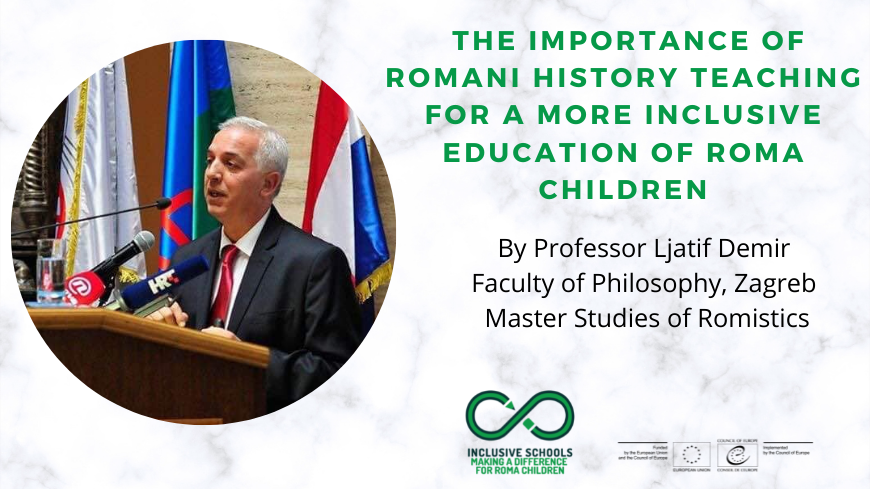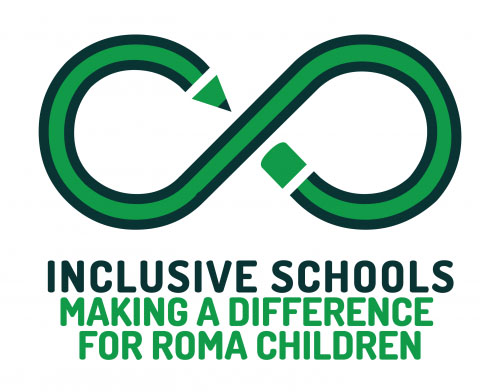The education of Roma children throughout history has always taken place in the language of the majority population. Roma children, from the beginning of their education, do not distinguish themselves by their language which has its own cultural values. With that, Roma lose the symbol of their collective identity, a sign that they belong to a certain community regardless of whether that language has a written form or not.
Oral creation and heritage are very important for the survival of the Roma people and their tradition. Romani language is very important for Roma students in understanding language diversity and intercultural communication. For them, the promotion of the mother tongue also means a better start in the acceptance of bilingualism and multilingualism. Bilingualism and multilingualism of Roma children are a condition for building connection with the majority population, their understanding of other nations and vice versa, is an encouragement for inclusion in education itself.
At the very beginning of their inclusion in education, Roma students face a language barrier, ie. very poor knowledge of the language and culture of the majority population, but also with the problem of segregation of Roma students in schools.
This segregation occurs in three forms: segregation between schools (due to the location of the school where the majority of residents are Roma); segregation in the schools themselves (formation of classes with only Roma students, or them being represented in large numbers); and segregation in special schools/classes for children with special education needs.
A particular challenge is the inability to distinguish between Roma students and students with special educational needs. The late enrollment in school, lack of opportunities to learn in their mother tongue and incorrect assessment mechanisms can lead to the labeling of a large percentage of Roma children as children with special education needs, and hence to inadequate educational opportunities, eg. to attend teaching in special schools (Demir, Fatime, 2020:17).
Lack of inclusive education (especially in the countries of Southeast Europe) reinforces social stigma, prejudice and intolerance towards Roma children in education. The implementation of inclusive education in schools is a relevant topic for the pedagogical and social context, because inclusion implies acceptance of diversity among students, which should be seen as an incentive (source of inspiration), not as an obstacle in the learning process and education (Karamatić Brčić, 2012). In order to implement and be successful in the inclusive education for Roma children in the regular (mainstream) school system, changes are needed in the overall school practice. Inclusion is a process that reaches the participation of all students. In that process, the exclusion of Roma children from the school curriculum and the culture of the wider society is reduced (Booth 1999; according to Karamatić Brčić, 2012). In that process, students, teachers, professional associates and parents should accept Roma children in the regular (mainstream) education system, and for that they should provide human, material and organizational resources.
Students of the majority population, as well as the Roma themselves, do not have the opportunity to get acquainted with the culture, history, language and tradition of the Roma, and thus they are deprived of the opportunity to respect diversity and the value of a person who is different, and all this results by creating prejudices.
Roma students are prevented from realizing their full potential and, in the end, all this brings into question their successful completion of school and the realization of their right to education. It is also very important to understand that the school is an institution in which similarities and differences meet and therefore the world that surrounds us should be properly presented, and that is the world of diversity.
The whole school system (when it comes to Roma students) should understand that:
- Inclusive education refers to the inclusion of children and adults who, due to their social, cultural, educational, ethnic and other differences, are susceptible to social exclusion, social marginalization, and thus are disadvantaged and vulnerable, and
- Inclusive education which emphasizes that each child is educated in accordance with his or her individual abilities in school as an educational institution.
According to Sebba and Sachdev (1997; according to the NCSE, 2010) schools, as an educational institution, should adopt a school curriculum and educational strategy that is tailored to the different needs of students. Stainback and Stainback (Stainback and Stainback, 1990; according to Cerić, 2004) therefore say that the inclusive school is a place where everyone belongs, everyone is accepted and is supported by their peers and other members of the school community to fully meet their educational needs.
Despite the efforts to adapt the school curriculum to the individual needs of students, still in the educational system, for Roma children, a curriculum that does not leave teachers too much space for improvisation and meeting the needs of Roma students still prevails. It still contains the traditional approach in which there is a pre-prescribed and programmed teaching that is made for the needs of the majority people.
In order to avoid such a rigid and inflexible school curriculum, and to achieve a quality educational practice that will offer acquaintance with the culture, history and language of the Roma, changes in norms, values, attitudes and mutual relations are needed, which in a way should build a culture of schools that builds and develops through the relationships between its participants, unites all who belong to it, shapes the behavior and influences the success of each actor and influences changes that avoid prejudice and social stigma. The main goal of school culture is to build a culture that determines both the school's identity and the student's identity. Creating an inclusive culture also refers to an inclusive policy in schools involving all students and an inclusive practice that organizes learning and mobilizes resources (material and human). This achieves the realization of inclusive education that is related to students, teachers, principals, professional associates, parents, local governments and education policy in a particular country. Such realization enables continuous cooperation between all stakeholders in the educational process and the old way of hierarchical arrangement of schools is lost.
An example of good practice in the inclusive education of Roma children can be achieved by including historical events relevant to Roma in the school curriculum through bilingual parallel textbooks (or through brochures on Roma history, culture and language, made in the official languages of certain countries and Romani language) and through training of all stakeholders in inclusive education on the history, culture and language of Roma in the schools themselves and at a wider European level. A good start would be the celebration of Roma International Days which are celebrated all over the world.
Sample topic: The importance of April 8 - International Roma Day as part of inclusive education
Historical concept of the Rromanipe process
The first Roma Congress was held from April 6-8 in 1971 in the vicinity of London. The congress was attended by 23 Roma from 8 countries. The congress presented the problems of the Roma in the field of Roma language, culture, education, social issues, the war crimes committed against the Roma during the Second World War and the obstacles for the progress of the local Roma in the countries represented in the Congress. A key part of the Congress was: the adoption of the Roma flag (two colors - green at the bottom and blue at the top, with a sixteen-foot wheel in the middle), anthem (Gelem, gelem, an old Roma song from Moldova, for which an arrangement was made by Z. Jovanovic from Serbia) and the joint harmonization of the need for a standard Romani language - Romani čhib. A consensus has been reached that all Roma dialects are considered equal and that no language or dialect is superior to another language or dialect. The need to work on the standardization of the Romani language in order to use one Romani language in schools, congresses, literary works, periodicals and non-periodicals is emphasized. The ethnonyms Cigan / Cigány were also discussed, Gypsy / Zingano / Zigeunare, Gitanos and Gypsy etc., with which non-Roma called Roma in the past and it was determined that the name Rom/Rrom, pl. Roma, Rroma, (Sinto, Sinte) with which Roma are calling themselves in the Roma community are the only name by which Roma will be called in the world. Slobodan Berberski, a writer from Serbia, was elected the first president of the International Roma Union, who has declared the following:
My people demand what all other nations have received - the right to be a nation. In due course, the Romani language will be taught in all schools where Roma study. We will apply for the opening of Departments for Romani language at the Faculties of Philology. We will ask for scholarships for all students who want to be educated. We will look for employment for the Roma. We need to demystify the old notion of Roma that they are an antisocial part of societies.
8 April, International Roma Day - Recommendation for realization of a lesson plan
Historical Concept - Reading the Historical Concept from a brochure (parallel textbook) in the official language of the country of instruction
Example:
Educational outcome |
Analysing the educational outcome |
|---|---|
| The student explains the dynamics and changes in the Roma community and history in the 60s and 70s of the 20th century. | The student compares the lives of the majority and Roma population in that period. |
| The student explains the benefits of the 1971 Roma Congress for Roma around the world. | The student lists the conclusions of the Congress. |
| The student explains the character and work of Slobodan Berberski. | The student reads part of S. Berberski's literature in the language of the majority and in Romani language. |
This achieves inclusive education which is described in the theoretical part of this article. This is a step forward in the inclusion of Roma students through their history which builds democratic citizenship in the educational process. This is of crucial importance for many countries in Europe. The result is that Roma students, as future citizens of Europe, are not forgotten and neglected as students of a national minority but they are part of our common WE, that they are not referred to in the plural third person THEY, that they are not anti-heroes of history and that, for them, the wording that excludes them as members of national minorities is not to be used.
Examples for implementation of a school lesson plan, after initial training for inclusive education approaches with Roma children, can be inspired by the resources available here: https://www.coe.int/en/web/roma-and-travellers/roma-history-factsheets
*This article was produced within the framework of the European Union and Council of Europe Joint Project “Inclusive Schools: Making a Difference for Roma Children” . The views expressed herein can in no way be taken to reflect the official opinion of either party.


